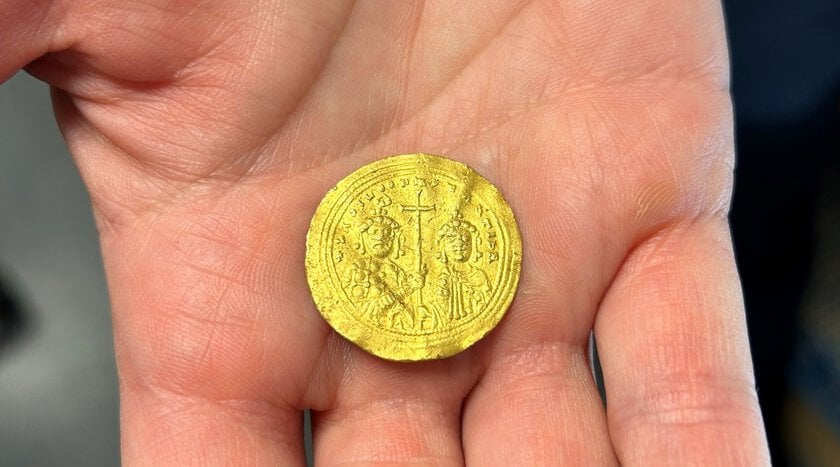
A metal detectorist has discovered a rare Byzantine coin in the mountains of Norway’s Vestre Slidre municipality, more than a millennium after it was created and over 1,600 miles away from its place of origin.
The gold coin is in excellent condition and is believed to have been minted between 977 and 1025 C.E., as indicated by dotted circles on the coin’s border. It is known as a “histamenon nomisma,” a coin of standard weight first introduced around 960. It was likely created in Constantinople (now Istanbul), the capital of the Byzantine Empire, also known as the Eastern Roman Empire.
Photo by Martine Kaspersen, courtesy of Innlandet County Municipality.
On one face of the coin is a depiction of Jesus, holding a Bible. On the other are images of brothers Basil II and Constantine VII, co-rulers of the Byzantine Empire. The two kings were coronated in the early 930s following the death of their father Romanos II, but as they were both still children—Constantine just three years old—the empire was ruled by two generals until Basil took his position as senior emperor. Basil’s nearly 50-year reign was the longest of any Roman emperor. Two inscriptions on the coin read “Jesus Christ, King of those who reign” in Latin, and “Basil and Constantine, emperors of the Romans” in Greek.
During Basil II and Constantine VII’s rule, the Byzantine empire had a population of around 12 million people and stretched from the Adriatic Sea to the Euphrates River.
Photo by Martine Kaspersen, courtesy of Innlandet County Municipality (2023).
One theory on how the coin appeared in the Norway was that it belonged to King Harald III (also known as Harald Sigurdsson, Harald Hardråde, Araltes, and Harald the Ruthless), who ruled the country between 1045 to 1066. Harald III had previously been a guard for Byzantine emperors for a period around 1034, which would have given him access to the coin. The custom of the time was that guards had the right to plunder the palace after the death of an Emperor, and during Harald’s stay in Byzantium, three emperors passed away. The coin may have later been used as part of a dowry, and was lost across the salt road routes which cross Norway.
Plans are in place for archaeologists to return to the Vestre Slidre site in 2024 to carry out further excavations.
More Trending Stories:
Inspector Schachter Uncovers Allegations Regarding the Latest Art World Scandal—And It’s a Doozy
Archaeologists Call Foul on the Purported Discovery of a 27,000-Year-Old Pyramid
A Polish Grandma Found a Rare Prehistoric Artifact—And Kept It Quiet for 50 Years
Art Critic Jerry Saltz Gets Into an Online Skirmish With A.I. Superstar Refik Anadol
Your Go-To Guide to All the Fairs You Can’t Miss During Miami Art Week 2023
The Old Masters of Comedy: See the Hidden Jokes in 5 Dutch Artworks
David Hockney Lights Up London’s Battersea Power Station With Animated Christmas Trees